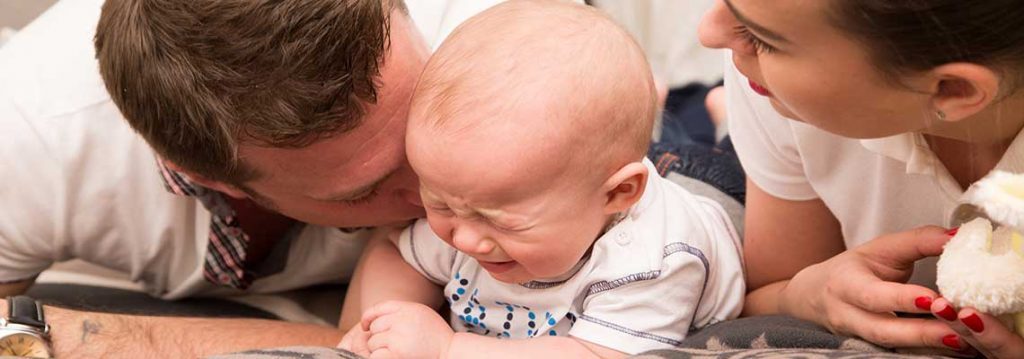
Guest Post: Amy Lu
 Bringing your newborn baby home from the hospital is often one of the most exciting days of a parent’s life. However, discerning why an infant is crying is not always something that comes naturally to parents. Here I outline the most common causes for babies to cry and how to quickly remedy the situation. In this No More Crying: Complete Baby Troubleshooting Guide parents will learn practical and easy steps to take to eliminate crying and soothe a troubled baby.
Bringing your newborn baby home from the hospital is often one of the most exciting days of a parent’s life. However, discerning why an infant is crying is not always something that comes naturally to parents. Here I outline the most common causes for babies to cry and how to quickly remedy the situation. In this No More Crying: Complete Baby Troubleshooting Guide parents will learn practical and easy steps to take to eliminate crying and soothe a troubled baby.
My first reaction when my baby cries and I don’t know why is to check the clock. Whether your baby is on a schedule or not, it will still give you a good indicator of what they might need. Think about the following questions: How long has it been since the baby last ate? When is the last time you changed his diaper? Have you burped him recently? This is a great place to start and will give you the quickest and most direct path to a solution.
I also highly recommend beginning a schedule with the baby. You can create whatever kind of schedule you like—feeding, changing, putting the baby to sleep—but it will create predictability for you and the baby which will make it easier to figure out quickly why your baby is crying. I prefer to do an eat/wake/sleep schedule that I have found also, in turn, helps my baby sleep through the night. Although I occasionally nurse my baby to sleep, the general outline is what you are really after as a parent.
Once you begin creating a routine, you will know what activity comes next and thus have a better idea of why the baby is crying. I always begin gently creating a schedule as soon as my baby is born. One of the best ways to do this is to use an app to track when the baby is eating, awake and sleeping. Once you have a rough schedule in place (whatever you decide that schedule looks like) you are ready for the following steps of the complete baby troubleshooting guide to discerning a baby’s cry by a process of elimination.
Complete Baby Troubleshooting Guide: Four Common Causes for Crying and Remedies
1. Baby is Crying During or Right After Eating
If your baby is crying while eating or just after, it is typically gas. If you are sure it’s not breastfeeding related, then you have two options to help eliminate gas. First, try burping the baby in several positions. The second is to place the baby on his back and gently bicycle his legs to help him release any gas. If that doesn’t work, your baby may still be hungry. Try offering him more milk.
2. Baby is Crying During Awake Time
Check the clock: Is he hungry, tired or wet? If not, try switching the position the baby is in. I found that my babies typically would grow restless in one position after 10 to 15 minutes, especially before they can move on their own. If that doesn’t help, burp and bicycle his legs to help eliminate gas.
3. Baby is Crying Just Before Naptime
 Prepare the baby for a nap with a fresh diaper and I recommend swaddling if possible, to help the baby stay asleep. Create a bedtime routine for the baby such as singing, rocking, snuggling and then laying the baby down to sleep. By creating a routine, your baby will start to learn sleep cues from your actions.
Prepare the baby for a nap with a fresh diaper and I recommend swaddling if possible, to help the baby stay asleep. Create a bedtime routine for the baby such as singing, rocking, snuggling and then laying the baby down to sleep. By creating a routine, your baby will start to learn sleep cues from your actions.
4. Baby is Crying at Bedtime
Crying at bedtime is one of the most common times for a baby to cry. Ask yourself the important questions: How long has it been since the baby last ate? Does he have a fresh diaper? Does he need to burp?
I have always found that my babies sleep the best when they are really full. In order to do this, I often would cluster feed them at night, if they seemed hungry. An example of cluster feeding might look like this: Feeding the baby at 6:00, 7:00, and then a final bedtime feeding at 8:00 p.m.
After making sure the baby is full, I then move to eliminating gas by burping or bicycling the baby’s legs.
If that is not working, another technique is to adjust the baby’s bedtime by 15 minutes because the baby may be crying from being overtired. For example, if the baby normally goes to bed at 8:00 p.m., try putting him to bed at 7:45. If you are still experiencing prolonged crying, gently adjust the bedtime until you find a time that works best for the baby.
Overview of No More Crying: The Complete Baby Troubleshooting Guide
The most important first step of the complete baby troubleshooting guide is to begin by checking the clock and ask yourself: How long has it been since the baby last ate? When is the last time you changed his diaper? Have you burped him recently? Once you have gone through each of those, select the scenario above that best describes your situation and go through the steps provided. There may be occasions such as growth spurts, sickness, or teething in which the baby may be fussier than usual and require more time and attention. Also, some medical conditions will lead to more crying, so if your baby is having prolonged periods crying, please contact your health care physician.
Disclaimer:
The information in this article is for informational purposes only, as I am not a health care physician. Please consult with your child’s health care physician before applying any of the tips provided.

Amy Lu is a mother of two and former first-grade teacher. She is the creator of MakingMotherhoodMatter.com and loves sharing practical parenting and pregnancy resources with moms and soon-to-be moms.


